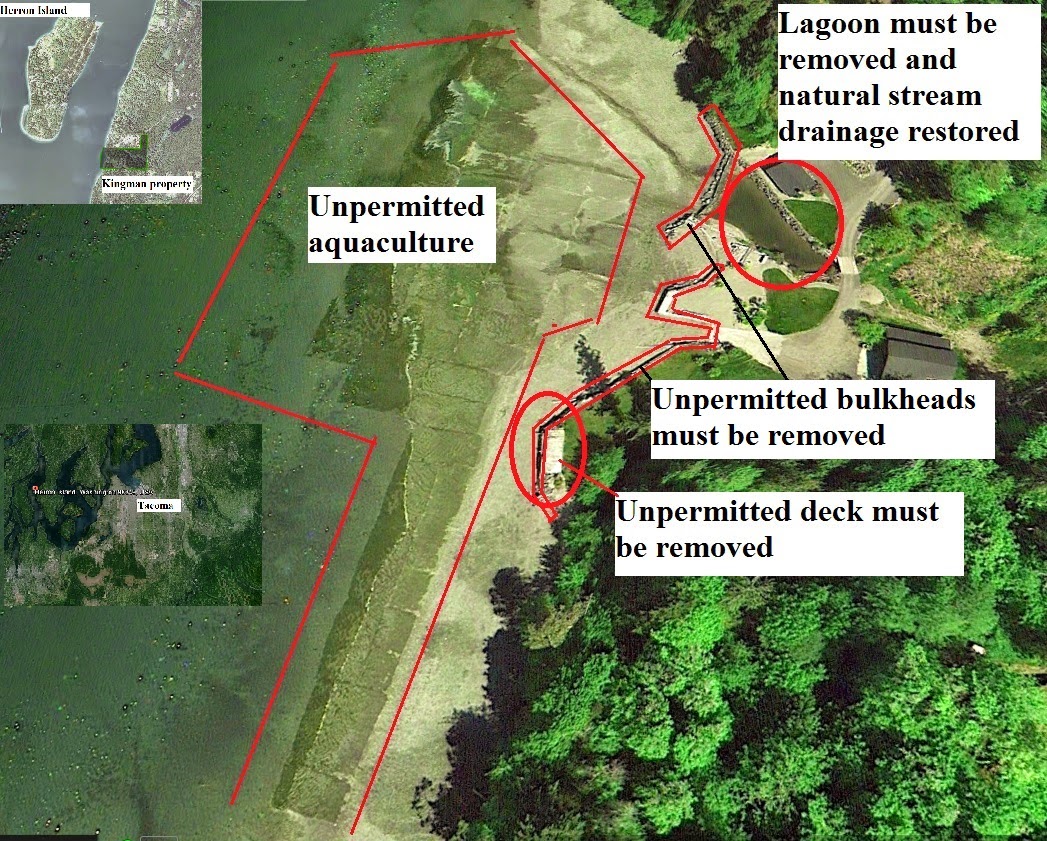Location of the proposed 11 acre "Haley" geoduck farm
on tidelands jointly owned by Taylor Shellfish family,
Seattle Shellfish, and those of the Haley (Almond Roca) family.
The
Coalition To Protect Puget Sound Habitat and neighbors of a proposed 11 acre geoduck farm on Case Inlet have appealed the Mitigated Determination of Non-Significance (MDNS) issued by Pierce County. It was felt the lack of analysis by Pierce County which preceded the MDNS decision would set a dangerous precedent for all of Puget Sound. Issues included such things as the large size of the farm; the lack of a clear indication of how the farm would be planted and harvested; and, little to no consideration of the current expansion of geoduck farming which is occurring and will occur in Puget Sound.
The appeal decision - a $2,900 investment in the future of Puget Sound
Unlike the past, it was strongly felt that not appealing the MDNS would set a dangerous precedent for all of Puget Sound. While an appeal fee of $2,900 had to be paid, the alternative of doing nothing would have left the door open for shellfish attorneys to claim, as they have in the past, that because "nobody appealed the MDNS" any environmental concerns should not be considered in the permitting process. It is an investment in the belief that the future of Puget Sound is in balance.
Overview of the Haley farm's location,
just north of Herron Island.
Access to tidelands is denied - "trust us"
Part of the decision rested on the fact that the Taylor family, Seattle Shellfish, and the Haley family refused to grant access to the tidelands to help scientists determine what was there. In the past, shellfish attorneys have stated because expert witnesses did not visit the specific site their testimony should be discounted if not ignored. Now, when given the opportunity to show that the contract scientists hired by the shellfish industry were, in fact, correctly analyzing the habitat, the shellfish industry denies access. Instead, they take a "trust us" attitude because their well paid contract scientists have been there.
Department of Natural Resources'
"Herron Lake" lease proposal,
south of the Haley farm.
Pierce County, and other counties, cannot operate in a vacuum - a current weakness in the Shoreline Management Act
Also at issue is the fact that Pierce County feels it is only obligated to look at what is occurring in Pierce County. In fact, south Puget Sound's habitat spans three separate counties with three separate approaches to how its tidelands are developed. Pierce and Thurston County both require permits, some more stringent than others, both complained about by the shellfish industry. Immediately to the west, Mason County has chosen to virtually ignore any regulatory oversight of geoduck farming, as seen in this permit note to Arcadia Point Seafood, with similar letters sent to others in the industry:
wrote letter to applicants, Steve and Vicki Wilson, cc'd DOE and Corps, approving proposal without need for SDP [shoreline development permit] or letter of exemption.
Minterbrook Oyster owner Kent Kingman's
unpermitted developments.
Even Pierce County is challenged by shellfish growers - Minterbrook Oyster owner Kent Kingman's unpermitted bulkheads, shellfish operation and old data
Despite Pierce County's permitting requirements, even shellfish growers make regulatory oversight difficult with unpermitted activities. Within the
Coalition's Shoreline Master Plan update submittal to Pierce County is a settlement agreement between Kent Kingman, current owner of Minterbrook Oyster, and Pierce County, for unpermitted developments on his shoreline property at the south end of Herron Island. Included is a major unpermitted shellfish operation; bulkheads; decks; and a dam blocking a stream which created a lagoon (see above and page 9 of the document). Currently, Taylor Shellfish has applied to operate the shellfish farm. Part of the application to resolve the violation incudes an
8 year old (2006) review done for both the DNR site and Mr. Kingman's, hoping to address the "Critical Fish and Wildlife Review." The report was done by Bioaquatics, owned by
Dan Cheney, also employed by the
Pacific Shellfish Institute. It does not appear any of the above was considered in the decision process which determined the outcome of the MDNS which the Coalition is appealing.
"You too can get rich!"
Really?
The tideland rush
Added to the above is a current rush by shellfish growers to lock up as many tidelands as possible for as long as possible. Industry is out of tidelands leaving only private and public tidelands left. Waving promises of great riches before tideland owners who are, for the most part, naïve of the long term consequences of their signing on the dotted line, shellfish growers lock them in to long-term leases with a small percentage paid to them. Not discussed is who will clean up the mess when this "geoduck bubble" crashes. It is not a matter of if, only a matter of when.
Support the Coalition and Case Inlet Shoreline Association
You can help the Coalition in its drive to protect Puget Sound's habitat as it was meant to be with a donation to the
Case Inlet Shoreline Association (CISA). CISA is a 501c3 organization so donations are tax deductible. More important is the future Puget Sound which you will help create.
























